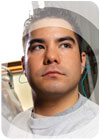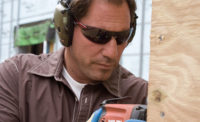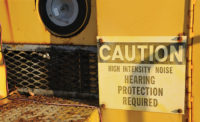
After 20 years of having hearing conservation standards in industry, noise-induced hearing loss continues to be one of the most common workplace injuries. Why does hearing loss still occur when an OSHA-standard program is in place? What can be done beyond OSHA compliance to reduce claims for hearing loss? OSHA’s hearing conservation regulations are a foundation for preventing noise-induced hearing loss in the workplace, but they rely on motivated employees, a trained workforce and carryover of good hearing conservation practices at home and recreational settings. Words like “motivation,†“recreational noise†and “comfortable earplugs†never appear in OSHA’s Hearing Conservation Amendment, yet they are indispensable in preventing noise-induced hearing loss.
Here are some recommendations to help you go beyond OSHA compliance to prevent hearing loss in your workplace.
Reducing exposures
Don’t assume the noise is insurmountable. A hearing conservation program for noise-exposed workers is not the first line of defense against hazardous noise; engineering and administrative controls should always be considered first. Elimination of the noise hazard at its source is the only guaranteed method of preventing workplace hearing loss. Although complete noise control is sometimes infeasible, many cost-effective engineering solutions can be implemented:- Buy quiet. Purchase new products with enhanced noise control.
- Retrofit. Ask manufacturers about mufflers or sound-damping materials that fit existing tools.
- Maintain. Noise is often a machine’s cry for maintenance. Repairs can reduce noise levels.
- Block. Erect barriers, or relocate noisy equipment (or their operators) behind heavy walls.
- Isolate. Doubling the distance from a noisy piece of equipment effectively reduces the sound energy by half (about a 3 decibel drop in noise level).
Employee training
Focus training on hearing conservation both on- and off-job. A worker who complies with all hearing protection requirements on the job may revel in noisy recreational activities off the job. And employers are often stuck with the responsibility for those non-occupational hearing losses when they show up in future audiometric testing.The principles of hearing conservation apply both on- and off-the-job. A 95 dB exposure at work is just as hazardous as a 95 dB exposure listening to loud music in the car, running power tools in the garage, or operating the lawnmower or edger in the yard. Teach employees to use hearing protectors for off-the-job exposures (many employers encourage their workers to use company-provided protectors for personal use during noisy off-job activities). Rule of thumb: If you must shout to be understood by someone standing an arm’s length away, then the background noise is probably hazardous.
One-on-one is best. Studies repeatedly confirm the advantage of one-on-one training and fit-testing and personal feedback in preventing hearing loss. For noise-exposed workers, that training is most effective when offered in conjunction with audiometric testing. Lower rates of hearing loss have been documented among employees who receive a copy and explanation of their audiometric results, compared to their co-workers who received no feedback.
Use audio samples. Most occupational injuries cannot be realistically simulated for training purposes. But hearing loss can be easily and accurately simulated with audio demonstrations, which are powerful motivators for noise-exposed workers. Good hearing loss simulations are available from NIOSH (http://www.cdc.gov/niosh/mining/products) as well as NASA (http://www.grc.nasa.gov/www/AcousticalTest). By demonstrating the frustrations of noise-induced hearing loss, you fast-forward for the employees the future risks of noise, and validate the preventive behavior that is needed now.
Hearing protectors
Offer an appealing choice of hearing protectors.OSHA mandates that employers offer “a variety of suitable hearing protectors,†meaning at least two protectors that adequately protect the workers from noise. But there are several additional factors that, if properly addressed, can dramatically increase employee acceptance. Individual differences in ear canal sensitivity and comfort mean some workers will prefer foam earplugs, while others prefer flanged; some will prefer earmuffs, while others prefer banded earplugs. A comfortable hearing protector is worn more consistently. Also, workers will intentionally compromise the fit of hearing protectors if they feel their own safety or job performance is impaired.Evaluate the effectiveness of hearing protectors. In judging whether earplugs and earmuffs are doing their job, we operate in the world of estimates. OSHA regulations rely upon an estimation of hearing protector effectiveness — the Noise Reduction Rating (NRR). Subtract the NRR from the measured noise levels (minus a 7 dB correction for A-weighted measurements) to estimate your protected noise exposures. But the NRR is a population average based upon laboratory test subjects, and in the real world some users will get more noise reduction than the NRR but many will get less. How much hearing protection are your employees really getting?
The answer lies literally in the hands of whoever fits the protector. A poorly fit earplug might look acceptable on the outside, but may be doing very little to protect hearing — effectively offering 0 dB of protection. Employees should be taught how to determine whether their earplugs are properly inserted. An earplug that is clearly visible from the front is a warning sign of poor insertion. For earplugs with a stem, only the tip of the stem should be visible to someone looking at you from the front, or when you view yourself in a mirror. All flanges of a flanged-earplug should be well inside the ear canal. For earplugs without stems (most foam earplugs), the ends of the earplugs should not be visible to someone looking at you from the front.
Document both protected and unprotected noise exposures. Documenting unprotected noise exposures is easily performed with a sound-level meter or noise dosimeter. But documenting protected noise exposures means measuring the noise level under the earplug or earmuff, a relatively new option that requires some innovative equipment (such as in-ear dosimetry). The result, however, is a rock-solid readout of exactly how much noise is entering the ear of a worker wearing hearing protection — invaluable evidence in evaluating claims of hearing loss due to workplace noise, and in separating occupational from recreational hearing loss.
Evaluate your program
Use annual audiometric testing as the acid test of hearing loss prevention. If OSHA-required hearing tests are administered, and then filed away, the annual audiometric testing becomes little more than a “hearing loss verification program†— simply monitoring the progression of inevitable noise damage. But if the audiometric tests are used as the acid test in evaluating the effectiveness of hearing conservation measures, then they become a “hearing loss prevention program.â€There are several indicators that can be used to measure effectiveness of a hearing conservation program; a reduction in noise levels or the number of workers exposed over 85 dBA are the best. (Simply measuring the number of workers wearing hearing protectors is not a good evaluator of success, since poor-fitting protectors will not prevent hearing loss.) But one of the easier and most common methods of evaluating effectiveness is counting the number (or rate) of workers with a significant decline in hearing (OSHA Standard Threshold Shift, or STS). Rates of zero percent STS are not only desirable but very achievable in hearing conservation programs that focus on hearing loss prevention, not simply OSHA compliance.
Having an OSHA-standard hearing conservation program in place is a great foundation, but is no guarantee of preventing workplace hearing loss. That requires going beyond OSHA compliance by motivating workers to practice good hearing protection all of the time and measuring those results with objective yardsticks.
Sidebar1:
Give workers a choice
Use your safety committee or a representative sample of workers to trial various hearing protectors in wear-tests. Their feedback will steer the selection of protectors that have the best chance of employee buy-in, based on a variety of attributes:- comfort;
- the ability to still hear critical warning sounds and conversation;
- corded or banded earplugs;
- roll-down versus no-roll foam;
- single-use or multiple-use; and
- compatibility with other personal protective equipment such as hard hats, safety eyewear, shields and helmets.


